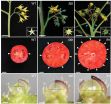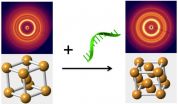Appropriate duration of dual antiplatelet therapy still unclear
Embargoed news from Annals of Internal Medicine
2015-05-26
(Press-News.org) 1. Appropriate duration of dual antiplatelet therapy still unclear
Free abstract: http://www.annals.org/article.aspx?doi=10.7326/M15-0083
URL goes live when embargo lifts
A systematic review of published evidence does little to clarify the appropriate duration of dual antiplatelet therapy (DAPT) following drug eluting stent placement. The evidence suggests that longer duration therapy decreases the risk for myocardial infarction, but increases the risk for major bleeding events, and may provide a slight increase in mortality. The results are published in Annals of Internal Medicine.
DAPT with aspirin and a P2Y12 inhibitor is usually administered for 6-12 months after drug eluting stent placement to prevent stent thrombosis. The appropriate duration of therapy is controversial because of the increased risk for bleeding. Researchers reviewed 9 published studies of randomized-controlled trials to compare clinical outcomes with longer versus shorter duration DAPT following drug eluting stent placement in adults with coronary artery disease. The data suggest that extended DAPT protects against myocardial infarction but increases major bleeding events and, possibly, mortality. The authors suggest that therapy duration should be based on patient preferences following a discussion of the benefits and harms.
Note: For an embargoed PDF, please contact Angela Collom at acollom@acponline.org. For an interview with the lead author, Dr. Gordon Guyatt, please contact Veronica McGuire at vmcguir@mcmaster.ca or 905-525-9140 x22169.
2. Contact tracing and monitoring exposes challenges of Ebola preparedness following cluster of U.S. cases
Free abstract: http://www.annals.org/article.aspx?doi=10.7326/M15-0968
URL goes live when embargo lifts
Actively monitoring and tracing contacts of a cluster of U.S. Ebola patients exposes the challenges associated with managing high-consequence communicable diseases, according to an article being published in Annals of Internal Medicine. Researchers suggest that planning for these challenges will strengthen collective preparedness for emerging diseases like Ebola and for resurgences of familiar diseases such as measles and tuberculosis.
Following the hospitalization and death of the first U.S.-diagnosed case of Ebola virus disease in September 2014, two health care workers who had cared for the patient were confirmed to have Ebola infections. Contact tracing methods were implemented to monitor those having personal or health care contact with the patient(s) for potential symptoms of Ebola virus. Researchers studied data on these contacts to assess implementation of contact tracing methods. They found that establishing accurate tracing and monitoring mechanisms was a particular challenge, as was data management. They suggest that preparedness activities include pre-designating a limited cadre of health care staff - including EMS and emergency room personnel - to interact with possible Ebola cases so that exposure is minimized. They also noted the challenge of large-scale application and enforcement of movement restrictions on a population. They suggest that humanitarian services be utilized to meet non-clinical needs and to protect the dignity and privacy of contacts under monitoring and quarantine.
Note: For an embargoed PDF, please contact Angela Collom at acollom@acponline.org. For an interview with an author at the CDC, please contact the CDC newsroom at media@cdc.gov or 404-639-3286. After 6 p.m., please call 770-488-7100.
INFORMATION:
ELSE PRESS RELEASES FROM THIS DATE:
2015-05-25
Ovarian cancer is notoriously difficult to diagnose and treat, making it an especially fatal disease. Researchers at University of California, San Diego School of Medicine and Moores Cancer Center have now identified six mRNA isoforms (bits of genetic material) produced by ovarian cancer cells but not normal cells, opening up the possibility that they could be used to diagnose early-stage ovarian cancer. What's more, several of the mRNA isoforms code for unique proteins that could be targeted with new therapeutics. The study is published the week of May 25 by the Proceedings ...
2015-05-25
Frailer older patients are at higher risk of readmission to hospital or death within 30 days after discharge from a general internal medicine ward, but health care professionals can assess who is at risk using the Clinical Frailty Scale, according to a study in CMAJ (Canadian Medical Association Journal)
Readmission within 30 days after hospital discharge is common and also costly for the health care system. Identifying at-risk patients and addressing the factors contributing to readmission can help reduce recurrences. However, current tools are not able to predict accurately ...
2015-05-25
This news release is available in French. Scientists measuring brain activity have found that in many regions, such as the sensory or motor cortex, activity sometimes oscillates at different frequencies, forming wave-like patterns. Despite the fact that such oscillations are frequently observed, and present in many brain regions, their functional role remains unclear. Research done by Dr. Christopher Pack, from McGill University, who looked at such waves occurring in a region of the visual cortex of the brain, suggests these oscillations could have a role in resetting ...
2015-05-25
Cold Spring Harbor, NY -- A team of scientists at Cold Spring Harbor Laboratory (CSHL) has identified a set of genes that control stem cell production in tomato. Mutations in these genes explain the origin of mammoth beefsteak tomatoes. More important, the research suggests how breeders can fine-tune fruit size in potentially any fruit-bearing crop. The research appears online today in Nature Genetics.
In its original, wild form the tomato plant produces tiny, berry-sized fruits. Yet among the first tomatoes brought to Europe from Mexico by conquistador Hernan Cortez in ...
2015-05-25
UPTON, NY -- Scientists at the U.S. Department of Energy's Brookhaven National Laboratory have just taken a big step toward the goal of engineering dynamic nanomaterials whose structure and associated properties can be switched on demand. In a paper appearing in Nature Materials, they describe a way to selectively rearrange the nanoparticles in three-dimensional arrays to produce different configurations, or phases, from the same nano-components.
"One of the goals in nanoparticle self-assembly has been to create structures by design," said Oleg Gang, who led the work ...
2015-05-25
New research conducted in a rural community in Pakistan highlights the crucial role that essential fatty acids play in human brain growth and function.
A team co-led by the University of Exeter, working with experts in Singapore, has published findings in Nature Genetics which show that mutations in the protein Mfsd2a cause impaired brain development in humans. Mfsd2a is the transporter in the brain for a special type of fat called lysophosphatidylcholines (LPCs) -- which are composed of essential fatty acids like omega-3. This shows the crucial role of these fats in ...
2015-05-25
Having a healthy gut may well depend on maintaining a complex signaling dance between immune cells and the stem cells that line the intestine. Scientists at the Buck Institute are now reporting significant new insight into how these complex interactions control intestinal regeneration after a bacterial infection. It's a dance that ensures repair after a challenge, but that also goes awry in aging fruit flies -- the work thus offers important new clues into the potential causes of age-related human maladies, such as irritable bowel syndrome, leaky gut and colorectal cancer.
"We've ...
2015-05-25
May 26, 2015, Shenzhen, China - Researchers from BGI reported the most complete haploid-resolved diploid genome (HDG) sequence based on de novo assembly with NGS technology and the pipeline developed lays the foundation for de novo assembly of genomes with high levels of heterozygosity. The latest study was published online today in Nature Biotechnology.
The human genome is diploid, and knowledge of the variants on each chromosome is important for the interpretation of genomic information. In this study, researchers presented the assembly of a haplotype-resolved diploid ...
2015-05-25
A gene essential to the production of pain-sensing neurons in humans has been identified by an international team of researchers co-led by the University of Cambridge. The discovery, reported today in the journal Nature Genetics, could have implications for the development of new methods of pain relief.
Pain perception is an evolutionarily-conserved warning mechanism that alerts us to dangers in the environment and to potential tissue damage. However, rare individuals - around one in a million people in the UK - are born unable to feel pain. These people accumulate numerous ...
2015-05-25
Scientists at the University of York's Centre for Quantum Technology have made an important step in establishing scalable and secure high rate quantum networks.
Working with colleagues at the Technical University of Denmark (DTU), Massachusetts Institute of Technology (MIT), and the University of Toronto, they have developed a protocol to achieve key-rates at metropolitan distances at three orders-of-magnitude higher than previously.
Standard protocols of Quantum Key Distribution (QKD) exploit random sequences of quantum bits (qubits) to distribute secret keys in a completely ...
LAST 30 PRESS RELEASES:
[Press-News.org] Appropriate duration of dual antiplatelet therapy still unclear
Embargoed news from Annals of Internal Medicine

